Abstract
1. We have used the patch-clamp technique to study modulation of the inwardly rectifying K+ current (IK(IR)) in cultured bovine pulmonary artery endothelial cells (CPAE cells). In whole-cell mode, IK(IR) was defined as the Ba(2+)-sensitive current. In single channel recordings, we observed a strongly inwardly rectifying and K(+)-selective channel with a conductance of 31 +/- 3 pS. 2. Reverse transcriptase-polymerase chain reaction (RT-PCR) analysis and functional data suggest that the endothelial IRK is most probably Kir2.1. 3. Intracellular ATP is required to prevent run-down of IRK in whole-cell mode. Single channel activity disappeared in inside-out patches exposed to ATP-free solution and in cell-attached patches on cells exposed to metabolic inhibition (KCN, 2-deoxyglucose). 4. The non-hydrolysable ATP analogues, ATP gamma S and adenylyl imidodiphosphate (AMP-PNP), did not prevent run-down. Run-down did not occur in the presence of okadaic acid, a phosphatase inhibitor, but was enhanced in the presence of protamine, an activator of phosphatase 2A (PP2A). 5. GTP gamma S and AlF4- inhibited IRK, also in the presence of ATP. GTP beta S antagonized the GTP gamma S effect. Pretreatment of the cells with PTX did not affect the GTP gamma S-induced inhibition. Okadaic acid, however, slowed this inhibition. 6. Neither activation of protein kinase A (PKA) nor activation of protein kinase C (PKC) affected IRK. Additionally, neither cytochalasin B nor a high concentration of intracellular Ca2+ affected the time course of IRK run-down. 7. We conclude that run-down of IRK is probably due to dephosphorylation by PP2A. Activation of a PTX-insensitive G protein inhibits this current by a mechanism that is neither mediated via the PKA and PKC pathways nor by intracellular Ca2+, but supposedly by a G protein-dependent activation of a phosphatase.
Full text
PDF
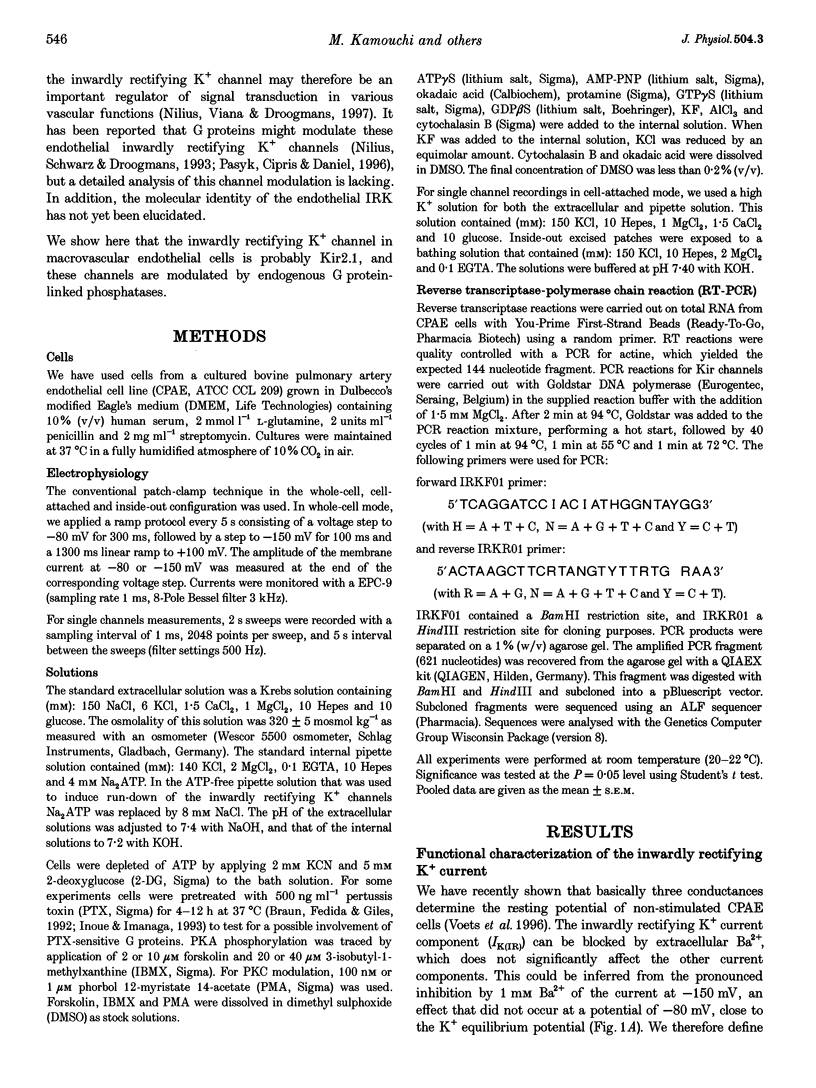
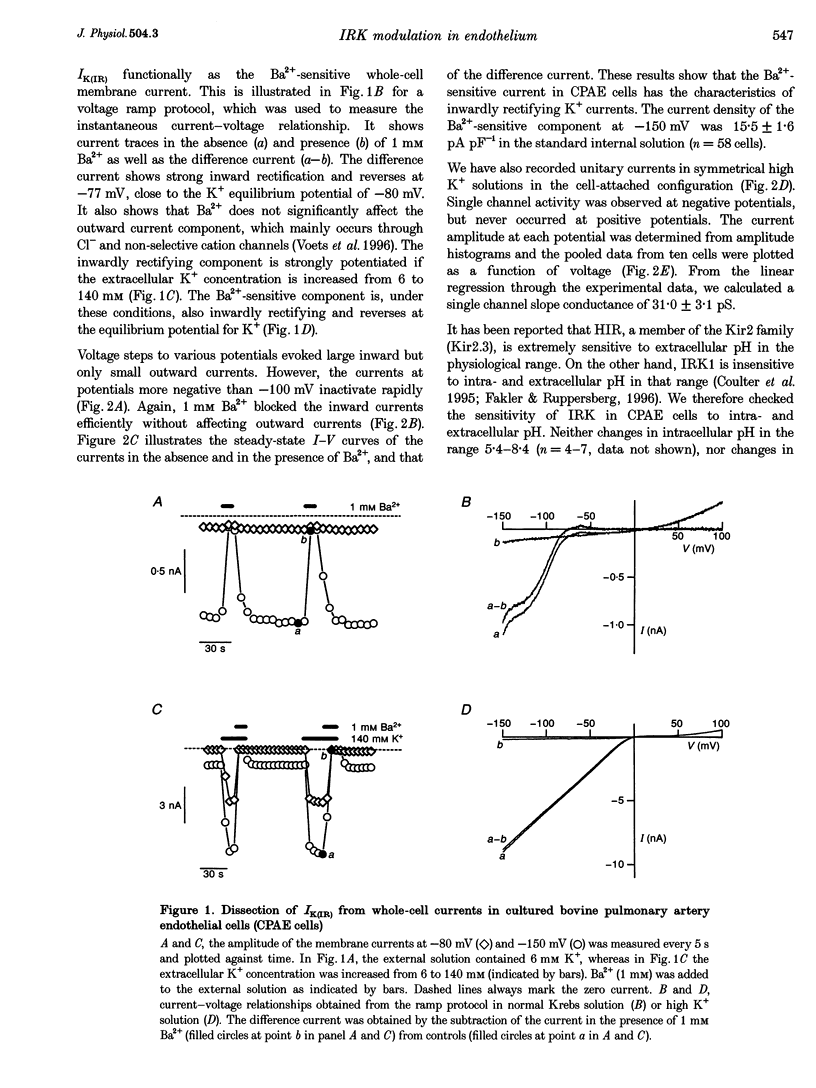
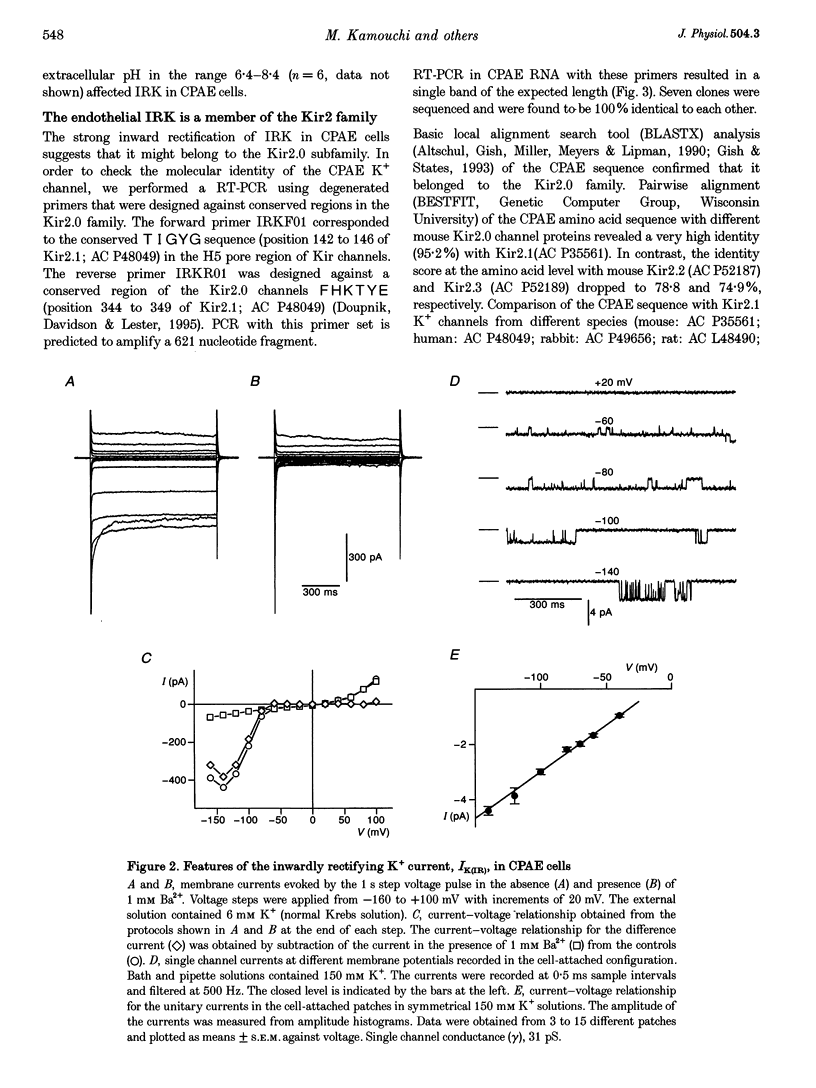
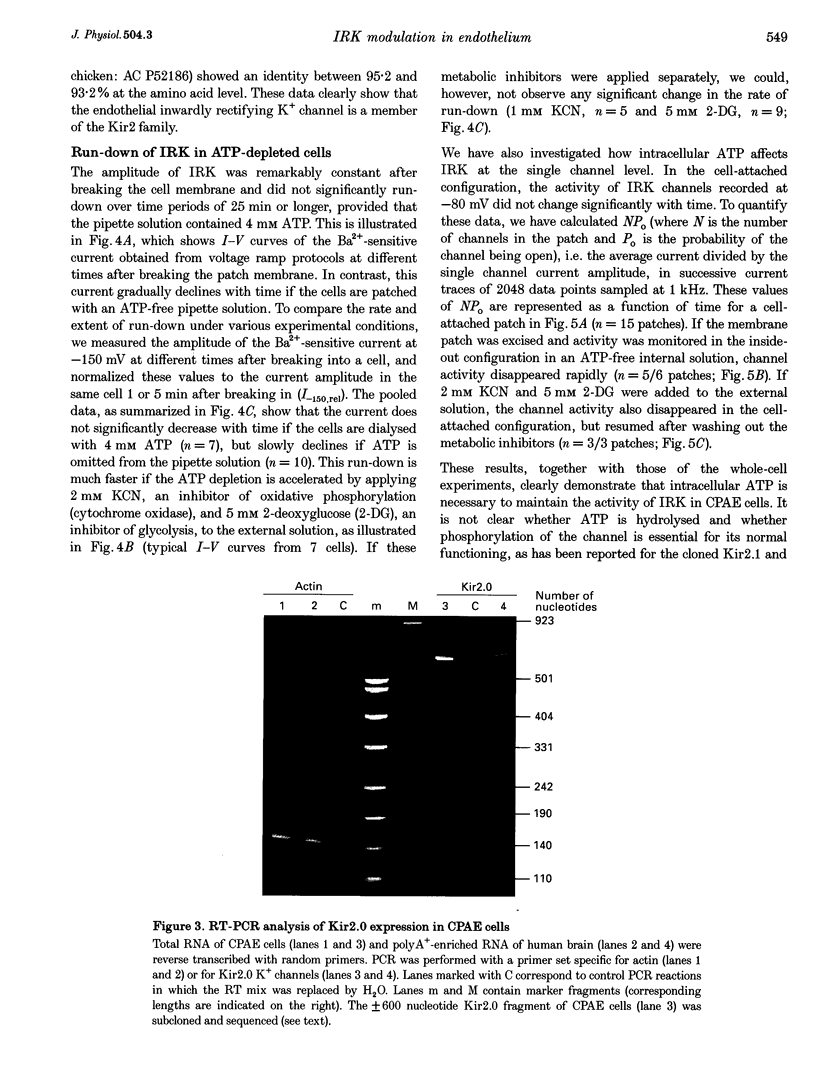
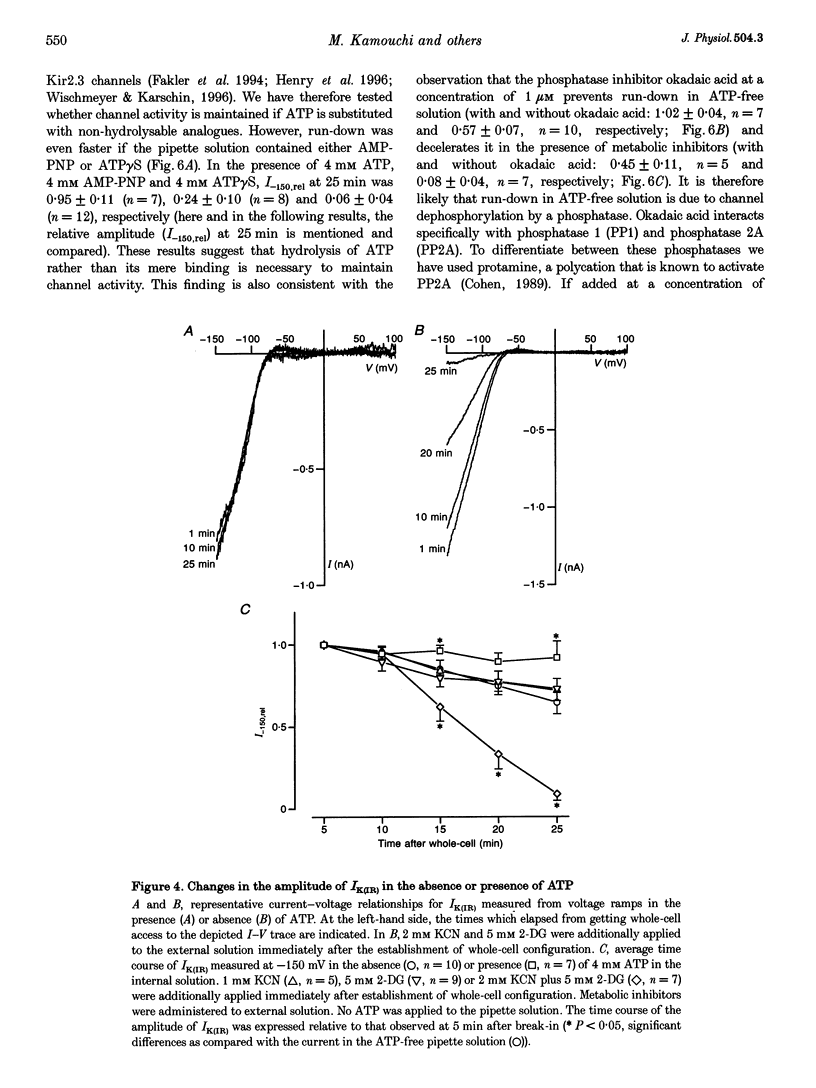
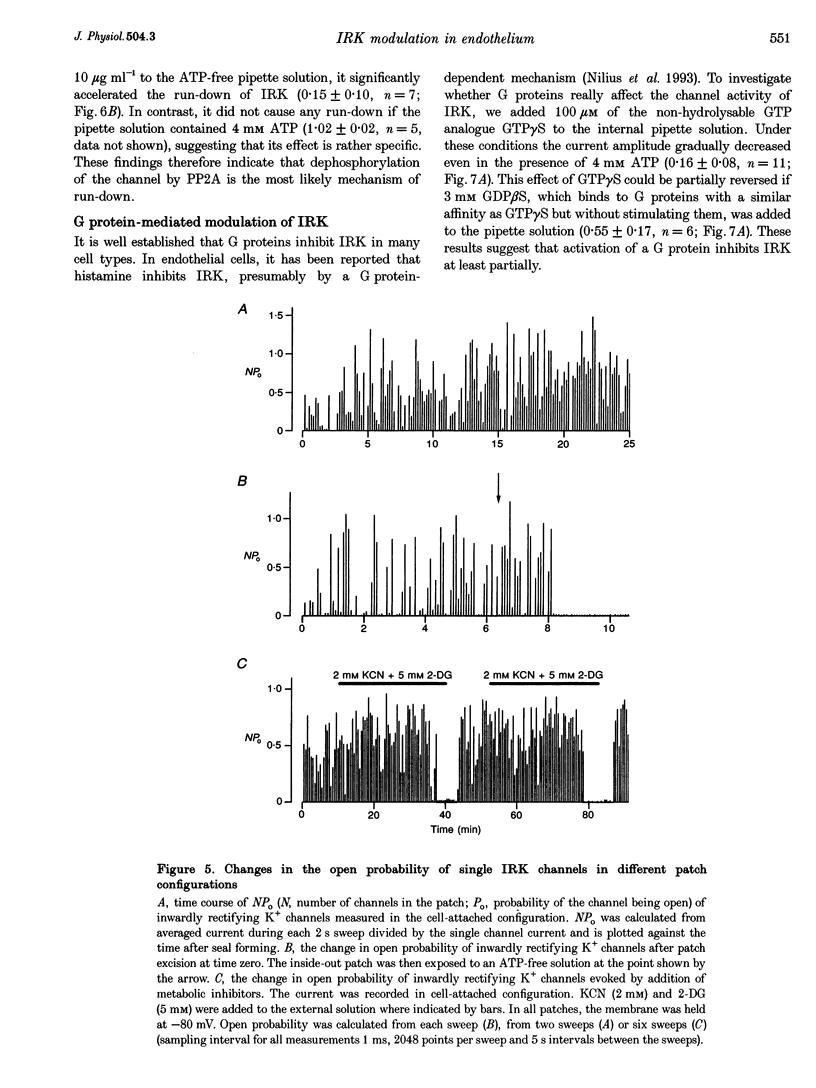
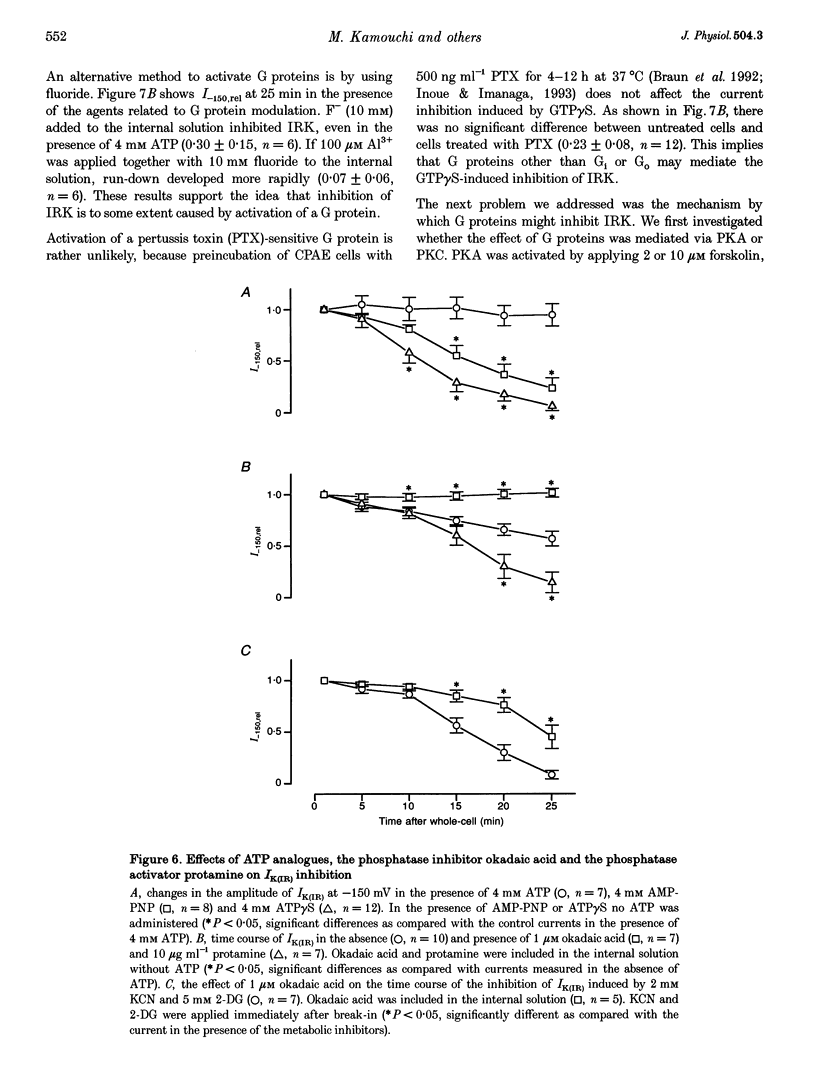
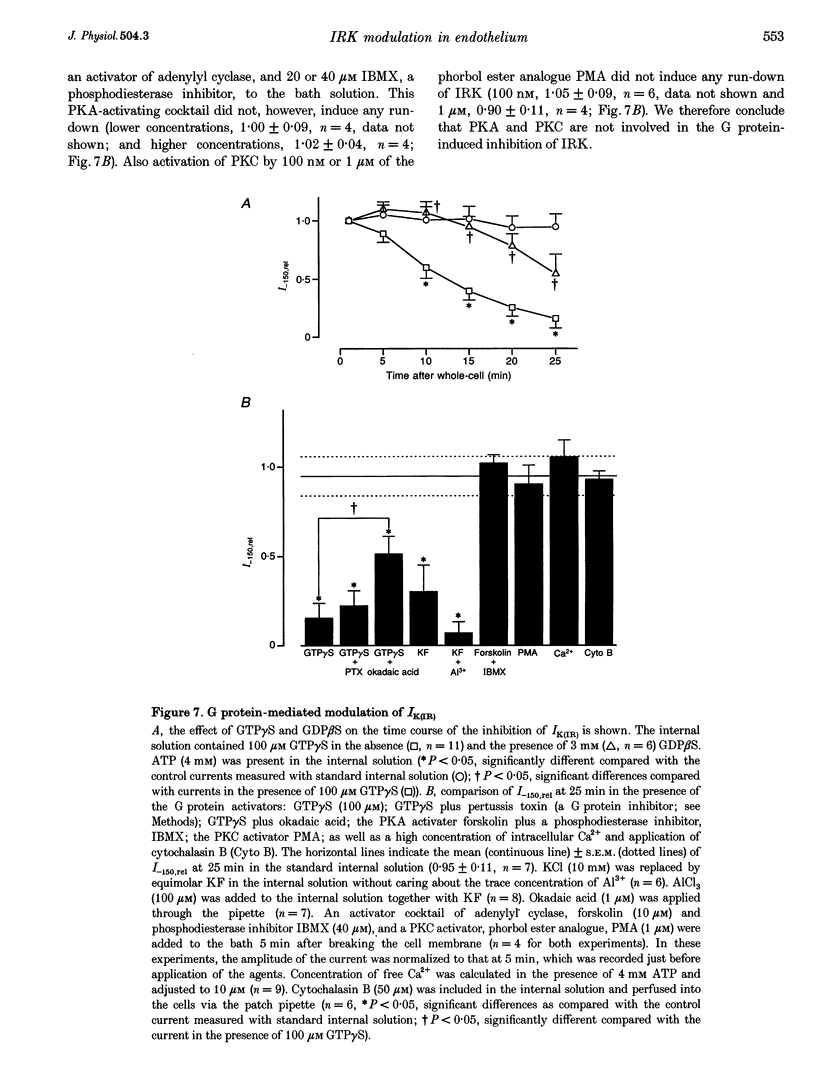
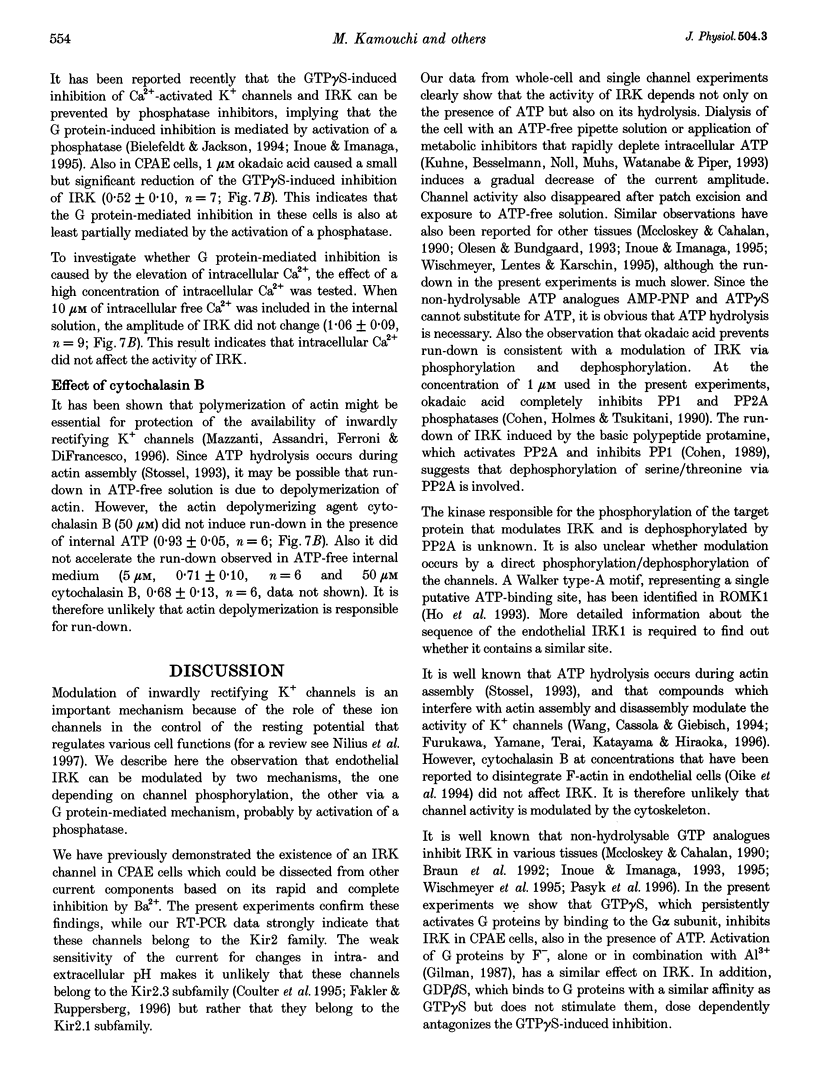
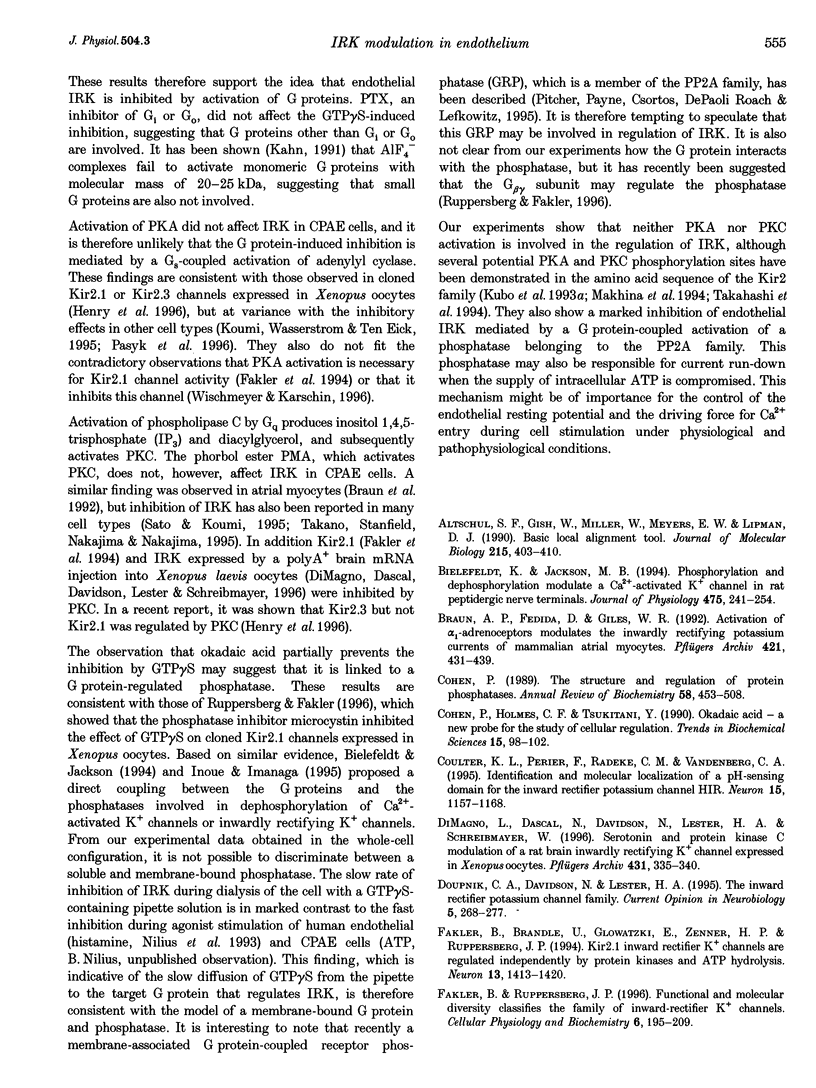
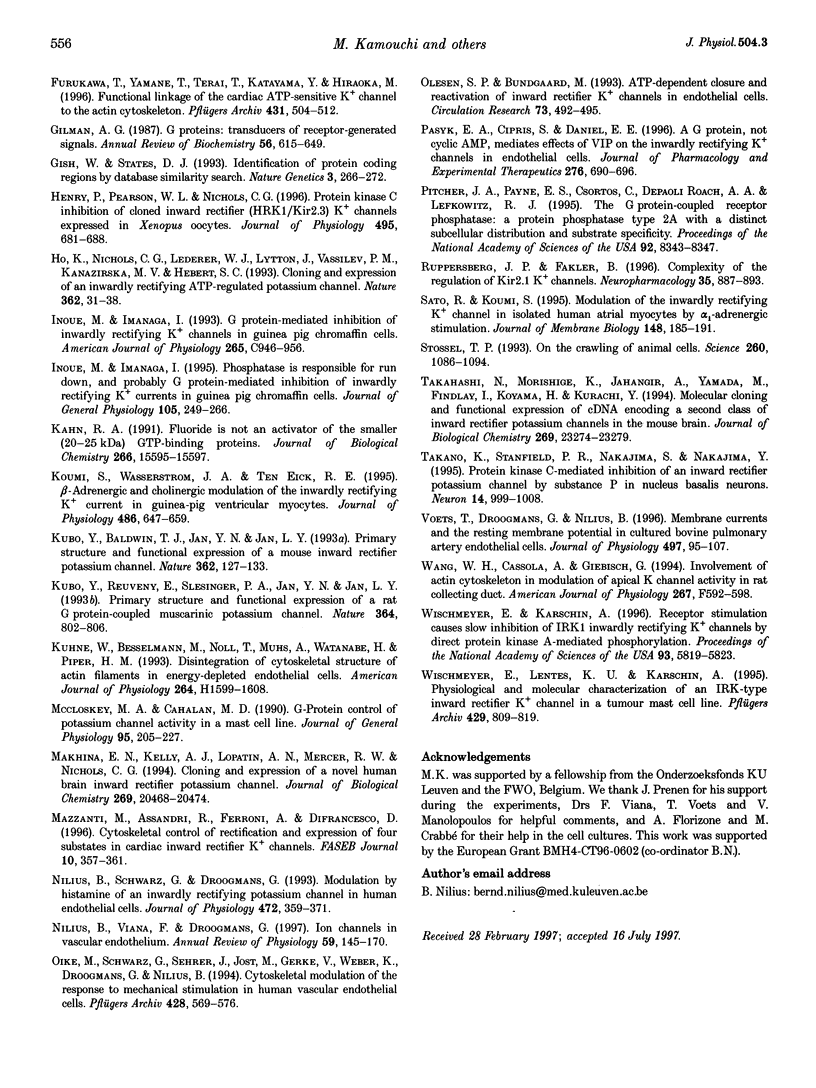
Images in this article
Selected References
These references are in PubMed. This may not be the complete list of references from this article.
- Altschul S. F., Gish W., Miller W., Myers E. W., Lipman D. J. Basic local alignment search tool. J Mol Biol. 1990 Oct 5;215(3):403–410. doi: 10.1016/S0022-2836(05)80360-2. [DOI] [PubMed] [Google Scholar]
- Bielefeldt K., Jackson M. B. Phosphorylation and dephosphorylation modulate a Ca(2+)-activated K+ channel in rat peptidergic nerve terminals. J Physiol. 1994 Mar 1;475(2):241–254. doi: 10.1113/jphysiol.1994.sp020065. [DOI] [PMC free article] [PubMed] [Google Scholar]
- Braun A. P., Fedida D., Giles W. R. Activation of alpha 1-adrenoceptors modulates the inwardly rectifying potassium currents of mammalian atrial myocytes. Pflugers Arch. 1992 Aug;421(5):431–439. doi: 10.1007/BF00370253. [DOI] [PubMed] [Google Scholar]
- Cohen P., Holmes C. F., Tsukitani Y. Okadaic acid: a new probe for the study of cellular regulation. Trends Biochem Sci. 1990 Mar;15(3):98–102. doi: 10.1016/0968-0004(90)90192-e. [DOI] [PubMed] [Google Scholar]
- Cohen P. The structure and regulation of protein phosphatases. Annu Rev Biochem. 1989;58:453–508. doi: 10.1146/annurev.bi.58.070189.002321. [DOI] [PubMed] [Google Scholar]
- Coulter K. L., Périer F., Radeke C. M., Vandenberg C. A. Identification and molecular localization of a pH-sensing domain for the inward rectifier potassium channel HIR. Neuron. 1995 Nov;15(5):1157–1168. doi: 10.1016/0896-6273(95)90103-5. [DOI] [PubMed] [Google Scholar]
- DiMagno L., Dascal N., Davidson N., Lester H. A., Schreibmayer W. Serotonin and protein kinase C modulation of a rat brain inwardly rectifying K+ channel expressed in xenopus oocytes. Pflugers Arch. 1996 Jan;431(3):335–340. doi: 10.1007/BF02207270. [DOI] [PubMed] [Google Scholar]
- Doupnik C. A., Davidson N., Lester H. A. The inward rectifier potassium channel family. Curr Opin Neurobiol. 1995 Jun;5(3):268–277. doi: 10.1016/0959-4388(95)80038-7. [DOI] [PubMed] [Google Scholar]
- Fakler B., Brändle U., Glowatzki E., Zenner H. P., Ruppersberg J. P. Kir2.1 inward rectifier K+ channels are regulated independently by protein kinases and ATP hydrolysis. Neuron. 1994 Dec;13(6):1413–1420. doi: 10.1016/0896-6273(94)90426-x. [DOI] [PubMed] [Google Scholar]
- Furukawa T., Yamane T., Terai T., Katayama Y., Hiraoka M. Functional linkage of the cardiac ATP-sensitive K+ channel to the actin cytoskeleton. Pflugers Arch. 1996 Feb;431(4):504–512. doi: 10.1007/BF02191896. [DOI] [PubMed] [Google Scholar]
- Gilman A. G. G proteins: transducers of receptor-generated signals. Annu Rev Biochem. 1987;56:615–649. doi: 10.1146/annurev.bi.56.070187.003151. [DOI] [PubMed] [Google Scholar]
- Gish W., States D. J. Identification of protein coding regions by database similarity search. Nat Genet. 1993 Mar;3(3):266–272. doi: 10.1038/ng0393-266. [DOI] [PubMed] [Google Scholar]
- Henry P., Pearson W. L., Nichols C. G. Protein kinase C inhibition of cloned inward rectifier (HRK1/KIR2.3) K+ channels expressed in Xenopus oocytes. J Physiol. 1996 Sep 15;495(Pt 3):681–688. doi: 10.1113/jphysiol.1996.sp021625. [DOI] [PMC free article] [PubMed] [Google Scholar]
- Ho K., Nichols C. G., Lederer W. J., Lytton J., Vassilev P. M., Kanazirska M. V., Hebert S. C. Cloning and expression of an inwardly rectifying ATP-regulated potassium channel. Nature. 1993 Mar 4;362(6415):31–38. doi: 10.1038/362031a0. [DOI] [PubMed] [Google Scholar]
- Inoue M., Imanaga I. G protein-mediated inhibition of inwardly rectifying K+ channels in guinea pig chromaffin cells. Am J Physiol. 1993 Oct;265(4 Pt 1):C946–C956. doi: 10.1152/ajpcell.1993.265.4.C946. [DOI] [PubMed] [Google Scholar]
- Inoue M., Imanaga I. Phosphatase is responsible for run down, and probably G protein-mediated inhibition of inwardly rectifying K+ currents in guinea pig chromaffin cells. J Gen Physiol. 1995 Feb;105(2):249–266. doi: 10.1085/jgp.105.2.249. [DOI] [PMC free article] [PubMed] [Google Scholar]
- Kahn R. A. Fluoride is not an activator of the smaller (20-25 kDa) GTP-binding proteins. J Biol Chem. 1991 Aug 25;266(24):15595–15597. [PubMed] [Google Scholar]
- Koumi S., Wasserstrom J. A., Ten Eick R. E. beta-adrenergic and cholinergic modulation of the inwardly rectifying K+ current in guinea-pig ventricular myocytes. J Physiol. 1995 Aug 1;486(Pt 3):647–659. doi: 10.1113/jphysiol.1995.sp020841. [DOI] [PMC free article] [PubMed] [Google Scholar]
- Kubo Y., Baldwin T. J., Jan Y. N., Jan L. Y. Primary structure and functional expression of a mouse inward rectifier potassium channel. Nature. 1993 Mar 11;362(6416):127–133. doi: 10.1038/362127a0. [DOI] [PubMed] [Google Scholar]
- Kubo Y., Reuveny E., Slesinger P. A., Jan Y. N., Jan L. Y. Primary structure and functional expression of a rat G-protein-coupled muscarinic potassium channel. Nature. 1993 Aug 26;364(6440):802–806. doi: 10.1038/364802a0. [DOI] [PubMed] [Google Scholar]
- Kuhne W., Besselmann M., Noll T., Muhs A., Watanabe H., Piper H. M. Disintegration of cytoskeletal structure of actin filaments in energy-depleted endothelial cells. Am J Physiol. 1993 May;264(5 Pt 2):H1599–H1608. doi: 10.1152/ajpheart.1993.264.5.H1599. [DOI] [PubMed] [Google Scholar]
- Makhina E. N., Kelly A. J., Lopatin A. N., Mercer R. W., Nichols C. G. Cloning and expression of a novel human brain inward rectifier potassium channel. J Biol Chem. 1994 Aug 12;269(32):20468–20474. [PubMed] [Google Scholar]
- Mazzanti M., Assandri R., Ferroni A., DiFrancesco D. Cytoskeletal control of rectification and expression of four substates in cardiac inward rectifier K+ channels. FASEB J. 1996 Feb;10(2):357–361. doi: 10.1096/fasebj.10.2.8641571. [DOI] [PubMed] [Google Scholar]
- McCloskey M. A., Cahalan M. D. G protein control of potassium channel activity in a mast cell line. J Gen Physiol. 1990 Feb;95(2):205–227. doi: 10.1085/jgp.95.2.205. [DOI] [PMC free article] [PubMed] [Google Scholar]
- Nilius B., Schwarz G., Droogmans G. Modulation by histamine of an inwardly rectifying potassium channel in human endothelial cells. J Physiol. 1993 Dec;472:359–371. doi: 10.1113/jphysiol.1993.sp019951. [DOI] [PMC free article] [PubMed] [Google Scholar]
- Nilius B., Viana F., Droogmans G. Ion channels in vascular endothelium. Annu Rev Physiol. 1997;59:145–170. doi: 10.1146/annurev.physiol.59.1.145. [DOI] [PubMed] [Google Scholar]
- Oike M., Schwarz G., Sehrer J., Jost M., Gerke V., Weber K., Droogmans G., Nilius B. Cytoskeletal modulation of the response to mechanical stimulation in human vascular endothelial cells. Pflugers Arch. 1994 Oct;428(5-6):569–576. doi: 10.1007/BF00374579. [DOI] [PubMed] [Google Scholar]
- Olesen S. P., Bundgaard M. ATP-dependent closure and reactivation of inward rectifier K+ channels in endothelial cells. Circ Res. 1993 Sep;73(3):492–495. doi: 10.1161/01.res.73.3.492. [DOI] [PubMed] [Google Scholar]
- Pasyk E. A., Cipris S., Daniel E. E. A G protein, not cyclic AMP, mediates effects of VIP on the inwardly rectifying K+ channels in endothelial cells. J Pharmacol Exp Ther. 1996 Feb;276(2):690–696. [PubMed] [Google Scholar]
- Pitcher J. A., Payne E. S., Csortos C., DePaoli-Roach A. A., Lefkowitz R. J. The G-protein-coupled receptor phosphatase: a protein phosphatase type 2A with a distinct subcellular distribution and substrate specificity. Proc Natl Acad Sci U S A. 1995 Aug 29;92(18):8343–8347. doi: 10.1073/pnas.92.18.8343. [DOI] [PMC free article] [PubMed] [Google Scholar]
- Ruppersberg J. P., Fakler B. Complexity of the regulation of Kir2.1 K+ channels. Neuropharmacology. 1996;35(7):887–893. doi: 10.1016/0028-3908(96)00092-5. [DOI] [PubMed] [Google Scholar]
- Sato R., Koumi S. Modulation of the inwardly rectifying K+ channel in isolated human atrial myocytes by alpha 1-adrenergic stimulation. J Membr Biol. 1995 Nov;148(2):185–191. doi: 10.1007/BF00207274. [DOI] [PubMed] [Google Scholar]
- Stossel T. P. On the crawling of animal cells. Science. 1993 May 21;260(5111):1086–1094. doi: 10.1126/science.8493552. [DOI] [PubMed] [Google Scholar]
- Takahashi N., Morishige K., Jahangir A., Yamada M., Findlay I., Koyama H., Kurachi Y. Molecular cloning and functional expression of cDNA encoding a second class of inward rectifier potassium channels in the mouse brain. J Biol Chem. 1994 Sep 16;269(37):23274–23279. [PubMed] [Google Scholar]
- Takano K., Stanfield P. R., Nakajima S., Nakajima Y. Protein kinase C-mediated inhibition of an inward rectifier potassium channel by substance P in nucleus basalis neurons. Neuron. 1995 May;14(5):999–1008. doi: 10.1016/0896-6273(95)90338-0. [DOI] [PubMed] [Google Scholar]
- Voets T., Droogmans G., Nilius B. Membrane currents and the resting membrane potential in cultured bovine pulmonary artery endothelial cells. J Physiol. 1996 Nov 15;497(Pt 1):95–107. doi: 10.1113/jphysiol.1996.sp021752. [DOI] [PMC free article] [PubMed] [Google Scholar]
- Wang W. H., Cassola A., Giebisch G. Involvement of actin cytoskeleton in modulation of apical K channel activity in rat collecting duct. Am J Physiol. 1994 Oct;267(4 Pt 2):F592–F598. doi: 10.1152/ajprenal.1994.267.4.F592. [DOI] [PubMed] [Google Scholar]
- Wischmeyer E., Karschin A. Receptor stimulation causes slow inhibition of IRK1 inwardly rectifying K+ channels by direct protein kinase A-mediated phosphorylation. Proc Natl Acad Sci U S A. 1996 Jun 11;93(12):5819–5823. doi: 10.1073/pnas.93.12.5819. [DOI] [PMC free article] [PubMed] [Google Scholar]
- Wischmeyer E., Lentes K. U., Karschin A. Physiological and molecular characterization of an IRK-type inward rectifier K+ channel in a tumour mast cell line. Pflugers Arch. 1995 Apr;429(6):809–819. doi: 10.1007/BF00374805. [DOI] [PubMed] [Google Scholar]



